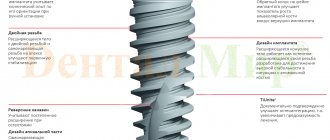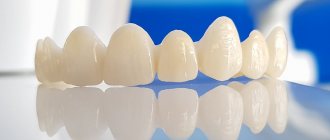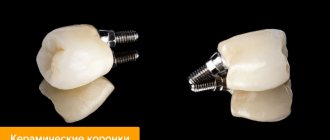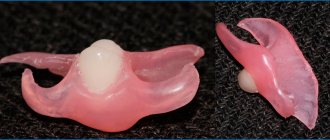Advantages
Prices
Doctors
Gallery
Reviews
Sign up
Metal-ceramic crowns consist of a metal frame with a layer of ceramic applied on top of it. The design is highly durable even under conditions of intense chewing load and can be used to restore individual teeth and create bridges.
Make an appointment
Advantages and disadvantages
Metal-ceramic crowns are one of the most popular types of prosthetics. The list of advantages of this technique includes:
- strength: the metal frame allows the structure to maintain its integrity even under conditions of high chewing load;
- comfort: a properly made prosthesis ideally replaces a lost tooth, does not injure the gums and mucous membranes, and also allows you to speak and chew freely;
- preservation of bone tissue: when fixing the crown to its own root or implant, bone atrophy is excluded;
- durability: with proper care, dentures last for years;
The main disadvantage of metal ceramics is the impossibility of prosthetics for the front teeth, since the metal base is visible through the surface layer.
Metal-ceramic crowns: pros and cons
Let's look at the advantages of metal-ceramic prostheses.
Hygiene
Bacteria practically do not settle on the ceramic surface. The materials do not have a negative effect on the microflora of the oral cavity, which allows the use of this type of crowns for people with oral diseases.
Durability
Metal-ceramic restorations are resistant to abrasion and deformation. They do not change color when exposed to food dyes or tobacco smoke. The service life of metal ceramics largely depends on the material from which the frame is made and averages from 10 to 15 years.
Versatility
Metal-ceramic dentures can be used to restore any teeth in the oral cavity. These crowns on the lateral areas of the teeth withstand the chewing load well, and in the smile area they are indistinguishable in appearance from a person’s own teeth.
Price
Metal ceramics are much cheaper than solid ceramic and zirconium crowns and are not much inferior in quality.
A significant disadvantage of metal-ceramics is the likelihood of chips and cracks in the ceramic layer.
Stages of prosthetics
The installation of metal-ceramic crowns takes place in stages:
- preliminary examination of the patient and drawing up a treatment plan;
- sanitation of the oral cavity with the removal of plaque and tartar, treatment of caries, inflammation of the gums and periodontal disease;
- preparing the tooth on which the crown will be installed: filling the canals (if it has not been done previously), turning for subsequent fastening of the prosthesis;
- taking impressions and transferring them to a dental laboratory, where a specialist will make the prosthesis itself; During manufacturing, a temporary plastic structure is placed on the tooth;
- fitting of the prosthesis: if the patient experiences discomfort, the crown is given to the technician for revision;
- final fixation with dental cement.
When and why are dental crowns installed?
Metal ceramics can be installed on:
- The patient’s own teeth, when the tooth root is not damaged, but the chewing element has significant defects.
- Implants implanted into the jaw bone instead of the root of a tooth.
- Bridges.
- Clasp dentures.
Indications for installing a crown on your own teeth include:
- More than 50% tooth decay.
- Mechanical damage (fractures, chips).
- Significant reduction in tooth height due to abrasion of enamel.
Implants are placed in place of a tooth that has been removed by the root. 1 lost tooth in the dentition requires 1 implant. If 3 or more units in a row are missing, you can limit yourself to two implants on which a bridge will be installed. The bridge can also be fixed on the patient’s own teeth, as a rule, after they have been previously depulped and ground down.
Indications and contraindications
Installation of metal-ceramic crowns is carried out in the presence of the following problems with chewing teeth:
- destruction of the coronal part by 2/3 or more due to mechanical damage or treatment of caries;
- malocclusions that cannot be corrected with orthodontic systems;
- cracks or chips of the crown part;
- increased abrasion of enamel.
Crowns can also be used when one or more teeth are completely missing; in this case, they are fixed to an implant.
Prosthetics are not possible in the following situations:
- high tooth mobility due to periodontal diseases;
- allergy to the materials that make up the structure;
- inflammatory focus in the oral cavity;
- the patient's serious condition due to diseases of the internal organs;
- mental disorders that do not allow free contact with the patient.
How much does cermet cost?
Structure of a metal-ceramic crown:
- The inner layer of the product is a metal frame.
- A layer of ceramic is applied to the frame on top.
The cost of metal-ceramic crowns depends on:
- The material from which the inner layer is made. For example, a crown with a frame made of gold or platinum will cost more than the same one, only with an inner layer of cobalt-chrome alloy.
- Method of crown installation. Preservation of the tooth root eliminates the need to install an implant and reduces the cost of the prosthetic procedure.
We present here the price for installing turnkey metal-ceramic crowns in St. Petersburg.
| Crown installation method | Cost, rubles |
| on your teeth | from 14 000 |
| on an implant | from 25 000 |
Advantages of the clinic
Doctors at the Kolibri clinic use the most reliable methods of dental prosthetics. Each client is guaranteed:
- individual approach to solving dental problems;
- safe and informative diagnostic techniques;
- modern materials for the manufacture of crowns and fillings;
- complete absence of pain during the prosthetic process;
- flawless execution of all manipulations;
- affordable prices for dental services.
A timely crown will protect the tooth from destruction and eliminate the need for implants. Don’t waste time, sign up for the Hummingbird Clinic.
Turnkey metal-ceramic crown: installation steps
Let's consider two routine situations for prosthetic dentists.
| Stages of prosthetics | On your own tooth | On implant |
| Initial consultation | The installation of crowns is preceded by an examination by a dentist, an x-ray examination, drawing up a prosthetic plan, and agreeing on the timing and cost of treatment with the patient. | |
| Preparation | Treatment of carious teeth, removal of teeth that cannot be treated, and professional oral hygiene procedures are carried out. If necessary, old fillings are replaced. | |
| Stage 1 | Preparing a tooth for installation of a crown usually includes depulping, root canal filling, and installing a pin or stump inlay. The tooth enamel is ground down to the thickness of the prosthesis (1.5-2 mm). | In place of the removed tooth root, an implant is installed into the jaw bone tissue. The artificial root can be covered with gum during healing (for up to 6 months), or a temporary crown can be installed on it, which will then be replaced with a permanent one. |
| Stage 2 | Metal-ceramic crowns are made individually for each person using impressions in a dental laboratory. At the first stage, a metal frame is cast, which is then covered with layers of ceramics. After firing, the product is additionally covered with a layer of glaze to match the color of the patient’s enamel. | |
| Stage 3 | After fitting and fitting the crown, it is permanently fixed in the dentition. | |
How is a metal-ceramic crown attached? There are two main methods of fixation:
- For cement. Special dental cement is applied to the prepared tooth stump or abutment (an adapter between a titanium implant and a crown), after which a cap-like prosthesis is placed on top.
- On the screw. Screws are used only when fixing crowns to implants. In this case, the prosthesis has a screw shaft on its chewing surface, which, after installing the crown, is closed with filling material.
The timing of installation of metal-ceramic crowns is determined by the time of their manufacture in the dental laboratory. On average, 10 days pass between preparing for prosthetics and installing metal ceramics on your teeth. During implantation, permanent fixation of the crown is carried out after complete engraftment of the artificial root, that is, 4-6 months after the operation to install the implant.
Our advantages
Qualified staff
All specialists of our clinic are licensed doctors with extensive experience
Personal approach to everyone
Individual solutions for each client, dental care for adults and children
Quality at affordable prices
Rational pricing and high quality of work and services provided
Convenient location
Two branches in the city center that are easy to find
Repair and restoration of metal-ceramic crowns
Loss of the aesthetic appearance of the crown due to the appearance of chips and cracks in the ceramic layer is not a problem. Damaged areas can be restored using composite materials.
The restoration procedure resembles the process of caries treatment, when an enamel defect is closed with a filling of a suitable shade. All manipulations are carried out in the patient’s oral cavity and do not require preliminary removal of the denture, but such a repair may not be very durable.
If dentures are significantly damaged and the metal frame is affected, they may need to be replaced. Old crowns are sawed down and removed, then impressions are taken and sent to a dental laboratory.
While new restorations are being made, the patient is not left without teeth thanks to the use of temporary crowns made of plastic. After fitting and fitting, the new permanent crown is installed in place of the old one.
Photos of the clinic
Photos before and after installing metal-ceramic crowns on teeth
An example of restoration of 3 broken and 1 protruding upper front teeth with metal-ceramics.
In the first photo, 2 upper lateral incisors are missing. On the second, metal-ceramic crowns on implants were installed in place of the missing teeth. A professional oral hygiene procedure, during which plaque and tartar are removed, makes your smile perfect.
Metal-ceramic crowns are installed on implants. In the first photo, one central incisor has been ground for an artificial crown and 3 artificial roots have been installed.
Artificial crowns were used to replace 2 removed lower incisors, as well as 2 destroyed lower incisors and 2 canines. As a result, the lower dentition looks ideal and at the same time absolutely natural.
In the first photo, the teeth are ground for crowns. The second photo is the result of restoration of the front teeth of the upper jaw with crowns. In terms of shade and wet shine, metal-ceramics are no different from the patient’s own teeth.
Our experience working with people shows that price matters. Therefore, we are ready to provide the best conditions for installing metal-ceramic crowns at affordable prices and with a guarantee of results. Want to know how much prosthetics will cost? Dial our clinic number, sign up for a consultation and get the best price offer. There is a system of individual discounts depending on the final cost of services.
Choosing the perfect color
In our clinic, you can count not only on restoring the main function of your teeth, but also on gaining a natural, radiant smile by installing dentures of the desired color, matching the rest of the units. An ideal result can be achieved using ceramic, metal-ceramic and plastic caps.
To select the ideal denture color, dentistry uses the Vita scale. This is a set of colors that is as close as possible to the existing shades of natural teeth. The crown, like veneers, made in our dental clinic will completely match the color of your teeth and will give you self-confidence.
Manufacturing prices vary somewhat depending on the structure of the material from which they are made. You can find out the cost of prosthetics in the price list, there are promotions. Additional consultation and information on services by phone: +7 (812) 670-62-70 , where you can also make an appointment or request a call back.
Types of crowns
You can install dentures in St. Petersburg from the following materials:
Metal teeth are made of titanium, chromium-cobalt steel, gold or platinum. Sometimes precious metals are used not as the base material, but for coating. The cost depends on the choice of metal.
Metal-ceramic for teeth. Metal ceramics are the best choice in terms of price/quality ratio. For their manufacture, a metal cap frame is used, which is coated on top with a ceramic coating of a natural color to match the patient’s teeth. It is more preferable to use zirconium dioxide as the base.
Ceramic for teeth. Porcelain products are suitable for installation on all teeth except chewing teeth. More suitable for selecting an exact color match to the patient’s tooth enamel. They are completely similar to natural units and look aesthetically pleasing. It is possible to choose not only the shade of the teeth, but also the desired degree of transparency.
Metal-plastic for teeth. Very often used as temporary during implantation. To maintain aesthetic appeal and good chewing function, a temporary cap is used during treatment. Its disadvantages are that it has a limited shelf life - up to three years, and can also change color or transparency over time, so it cannot be replaced with a permanent crown.
Plastic or resin dental crowns can be installed fairly quickly. They are used as a temporary solution for the period of implantation or prosthetics. The main disadvantage is fragility and darkening.
Zirconium.
Zirconium dioxide or zirconium oxide metal is a truly high-quality, high-level material for prosthetics. It has such properties as: hypoallergenicity, strength, lightness, reliability and aesthetics. If the prices for zirconium dioxide products are acceptable for you, feel free to choose this material.
If the tooth does not respond to treatment and cannot be restored, dentistry allows an implantation procedure. A zirconium abutment in combination with a ceramic crown is the optimal solution if you need to make a front tooth.











